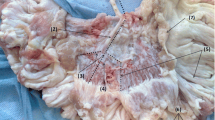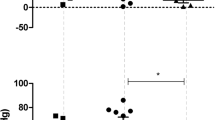Summary
-
1.
It is demonstrated in bullfrogs that efferent “sympathicus via posterior root”, a new efferent autonomic nerve, possesses a vasodilator action on mesenterial small arteries.
-
2.
The blood of a bullfrog which has developed a vasodilation due to stimuli given to efferent “sympathicus via posterior root” possesses a vasodilator action on another bullfrog's mesenterial small arteries.
-
3.
The vasodilator action of the “sympathicus via posterior root blood” is increased by eserine and abolished by atropine.
-
4.
The vasodilator effect of the “sympathicus via posterior root blood” on the mesenterial small arteries corresponds with the vasodilator effect of a 10\t-6 to 10\t-8 acetylcholine-Ringer's solution.
-
5.
When the “sympathicus via posterior root blood” is eserinized and applied to eserinized leech dorsal muscles there develops a marked muscular contraction.
-
6.
It is demonstrated that the blood subject to stimulation of efferent “sympathicus via posterior root” contains an acetylcholine like substance. Thus efferent “sympathicus via posterior root” proves to be a vasodilator nerve of cholinergic nature.
-
7.
It is demonstrated that the vasodilator effect of the “sympathicus via posterior root blood” on the mesenterial small arteries is similar to the vasodilator effect of the “vagus blood”.
-
8.
It is confirmed that stimuli given to ordinary “sympathicus via anterior root” result in a vasoconstriction in mesenterial small arteries.
-
9.
It is assumed that the blood, under stimulation of “sympathicus via anterior root”, contains an adrenaline like substance which may constrict another bullfrog's mesenterial small arteries.
The vasoconstrictor effect of the “sympathicus via anterior root blood” on the mesenterial small arteries corresponds with the vasoconstrictor effect of a 10−4 to 10−7 adrenaline-Ringer's solution.
-
5.
It is revealed that mesenterial small arteries of bullfrog's are subject to efferent “sympathetic antagonistic double innervation” of the cholinergic sympathetic vasodilator nerve, i.e., efferent “sympathicus via posterior root” and the adrenergic sympathetic vasoconstrictor nerve, i.e., “sympathicus via anterior root”.
The sympathetic (”sympathicus via posterior root” and ‘sympathicus via anterior root”) neuroeffector transmission mechanism is clearly explained by a chemical transmission mechanism.
An outline of the present paper was presented at the First General Meeting of the Japanese College of Angiology (1960) and at the 10th Japan Branch Conference of the International Society of Neurovegetative Research (1960).
Zusammenfassung
-
1.
Der Verfasser stellte fest, daß die von ihm entdeckten, efferenten autonomen Nervenfasern, “Sympathicus via Hintere Wurzel” (SHW), eine vasodilatatorische Wirkung auf die kleineren Mesenterialarterien (MA) beim Ochsenfrosch besitzen.
-
2.
Das Blut des Frosches, bei dem die Vasodilatation durch Reizung des SHW hervorgebracht wurden (SHW-Blut), war imstande, eine Dilatation der MA eines anderen Frosches auszulösen.
-
3.
Die vasodilatatorische Wirkung des SHW-Blutes wird durch Eserin verstärkt und durch Atropin abgeschwächt.
-
4.
Die gefäßerweiternde Wirkung des SHW-Blutes entspricht der einer Acetylcholin-Ringerlösung von 10−6 bis 10−8.
-
5.
Das eserinisierte SHW-Blut rief eine auffallende Kontraktion der eserinisierten Rückenmuskeln des Blutegels hervor.
-
6.
Aus der oben beschriebenen Tatsache ist es erklärlich, daß im SHW-Blut eine acetylcholinartige Substanz enthalten ist. Damit ist der Beweis geliefert, daß “Sympathicus via Hintere Wurzel” (efferent) cholinergische Vasodilatatoren sein müsse.
-
7.
Dieser vasodilatatorische Effekt des SHW-Blutes ist ähnlich dem vasodilatatorischen Effekt des Blutes, das nach Reizung des Vagus erhalten wird.
-
8.
Durch Reizung des in den vorderen Wurzeln verlaufenden Sympathicus (“Sympathicus via Vordere Wurzel”) (SVW), hingegen ließ sich eine Vasokonstriktion der MA auslösen.
-
9.
Es wird angenommen, daß in dem unter SVW-Reizung entnommenen Blut eine adrenalinartige Substanz enthalten ist, die auch bei einem anderen Frosch die Vasokonstriktion der MA auslösen kann.
-
10.
Aus dem Gesagten (1 bis 9) gelangt Verfasser zu nachstehenden Schluß-folgerungen: Die kleineren Mesenterialarterien des Ochsenfrosches stehen unter einer doppelten (efferenten) antagonistischen Innervation, und zwar unter der Herrschaft der cholinergisch-sympathischen Vasodilatatoren (“Sympathicus via Hintere Wurzel”) und der adrenergisch-sympathischen Vasokonstriktoren (“Sympathicus via Vordere Wurzel”). Der sympathische neuroaffektorische Übertragungsmechanismus (SHW und SVW) wird durch einen chemischen Übertragungsmechanismus erklärt.
Résumé
-
1.
Il est démontré que chez les crapauds, le nerf sympathique efférent par la racine postérieure, un nerf efférent autonome qui a été trouvé nouvellement, poss\`ede une action vasodilatatrice dans les petites art\`eres mésentériques.
-
2.
Le sang Svprb du crapaud, qui a développé une vasodilatation due aux stimuli provoqué dans le sympathique efférent via la racine postérieure, ce sang poss\`ede une action vasodilatatrice sur les petites art\`eres mésentériques d'un autre crapaud.
-
3.
L'action vasodilatatrice du \lasang de la racine postérieure qui passe dans la sympathique\ra (Svprb) est augmentée par l'ésérine et abolie par l'atropine.
-
4.
L'effet vasodilatateur du sang Svprb sur les petite art\`eres mésentérique correspond \`a l'effet vasodilatateur d'une solution de Ringer de 10\t-6 \`a 10\t-8 acétylcholine.
-
5.
Quand le Svprb est ésérinisé et appliqué aux muscles dorsaux de la sangsue ésérinisée, il cause une contraction musculaire évidente.
-
6.
Il est démontré que le sang Svprb contient une substance semblable \`a l'acétylcholine. Le nerf sympathique qui passe dans la racine postérieure est un nerf vasodilatateur cholinergique.
-
7.
L'effet vasodilatateur du sang Svprb sur les petites art\`eres mésentériques est similaire \`a celui du nerf vague.
-
8.
Les stimuli appliqués au nerf sympathique ordinaire qui passe dans la racine antérieure produit la vasoconstriction dans les petites art\`eres mésentériques.
-
9.
Le sang Svarb du crapaud, dont le nerf sympathique qui passe dans la racine antérieure est stimulé, contient une substance semblable \`a l'adrénaline, qui peut contracter les petites art\`eres mésentériques du crapaud.
L'effet du sang Svarb correspond à l'effet vasoconstricteur de la solution d'adrénaline-Ringer de 10−4 à 10−7.
-
10.
Les petites art\`eres mésentériques des crapauds sont sujettes \`a l'innervation double du nerf sympathique efférent, \`a savoir; d'un côté par le nerf vasodilatateur sympathique cholinergique qui passe dans la racine postérieure, de l'autre côté par le nerf vasoconstricteur sympathique adrénergique qui passe dans la racine antérieure. Le mécanisme transmetteur neuro-effectif sympathique (les sympathiques par la racine postérieure et la racine antérieure) s'explique clairement par le mécanisme transmetteur chimique.
Similar content being viewed by others
References
Langley, J. N., The sympathetic and other related system of nerves. Ed. by Schafer. Textbook Physiol.2 (1900), 616–691.
Langley, J. N., The origin and course of the vaso-motor fibers of the frog's foot. J. Physiol.41 (1910), 483–498.
Langley, J. N., andL. A. Orbeli, Observations on the sympathetic and sacral autonomic system of the frog. J. Physiol.41 (1910), 450–482.
Langley, J. N., Antidromic action. Part I. J. Physiol.57 (1923), 428–446.
Langley, J. N., Antidromic action. Part II. J. Physiol.58 (1923), 49–69.
Kotsuka, K., andH. Naito, A critique of Langley's antidromic action. J. Physiol. Soc., Japan,22, 4 (1960), 279.
Kotsuka, K., andH. Naito, A critique of Langley's antidromic action. J. Physiol. Soc., Japan,22, 8 (1960), 760.
Kotsuka, K., The Problems of Conduction of Excitation. Ishiyaku, Tokyo,I (1959), 360.
Oki, K., Studies on the vasomotor innervation in the external eye muscle of bull frogs and frogs. J. Kansai Med. Sch.11, 2 (1959), 117–128.
Horikawa, S., On the vasodilator action of efferent “sympathicus via posterior root”. J. Kansai Med. Sch.11, 4 (1959), 30–58.
Kotsuka, K., andH. Naito, A study on sympathetic nerve control in the cardiac activities of cold blooded animals. Med. J. Osaka Univ.11, 1/2 (1960), 35–48.
Kotsuka, K., andH. Naito, The pupilloconstricting action of “sympathicus via posterior root” of bull-frogs. Med. J. Osaka univ.11, 1/2 (1960), 49–68.
Minz, B., Pharmakologische Untersuchungen am Blutegelpräparat, zugleich eine Methode zum biologischen Nachweis von Azetylcholin bei Anwesenheit anderer pharmakologisch wirksamer körpereigener Stoffe. Arch. exper. Path. Pharmak., Leipzig,168 (1932), 292–304.
Fühner, H., Untersuchungen über den Synergismus von Giften. IV. Die chemische Erregbarkeitssteigerung glatter Muskulatur. Arch. exper. Path. Pharmak., Leipzig,82 (1918), 57–80.
Stricker, S., Untersuchungen überdie Gefäßnervenwurzeln des Ischiadicus. Wien. S.ber.74 3 (1876), 173. (Cited fromBayliss, W. M., The vasomotor system. Longmans, Green and Co., London, 1923.)
Bayliss, W. M., On the origin from the spinal cord of the vasodilator fibers of the hindlimb and on the nature of these fibers. J. Physiol.26 (1901), 173–209.
Bayliss, W. M., Further researches on antidromic nerve impulses. J. Physiol.28 (1902), 276–299.
Pick, J., Sympathectomy in amphibians. J. Comp. Neurol., Philadelphia,107 (1957), 169–200.
Nishinaka, H., andF. Ohguchi, The functional significance of the autonomic nerve fibers in the posterior roots of the spinal cord. The degeneration experiment of the posterior roots. J. Physiol. Soc., Japan,21 (1959), 782–786.
Langworthy, O. R., General principles of autonomic innervation. Arch. Neurol. Psychiatr., Chicago,50 (1943), 590–602.
Cannon, P., W. Raule undH. Schaeffer, Zur Physiologie eines sympathischen Ganglions und zur Frage der Vasodilatatoren und des sympathischen Tonus. Pflügers Arch. Physiol.260 (1954), 116–136.
Folkow, B., Nervous control of the blood vessels Physiol. Rev., Baltimore,35 (1955), 629–663.
Lucas, A., andJ. E. Miksicek, Nerve cells without central processes in the fourth spinal ganglion of the bullfrog. Science84 (1936), 207–208.
Sugimoto, S., The studies on the nerve fiber constitution of the various peripheral nerves by the method of morphological logical differentiation between the somatic and autonomic nerve fibers. J. Physiol. Soc., Japan,21 (1959), 710–713.
Nishinaka, H., On the origin of the autonomic nerve fibers from the spinal cord. Part III. The autonomic nerve fibers in the ventral and dorsal roots of toad. J. Physiol. Soc. Japan,21 (1959), 722–725.
Nishinaka, H., On the location of the peripheral ganglionic cells of the efferent myelinated autonomic nerve fibers contained in the spinal posterior roots. J. Physiol. Soc., Japan,21 (1959), 785–790.
Nakanishi, M., The antagonistic sympathetic innervation of the skeletal muscles. Nagai Shoten, Osaka,1958, 110.
Nakanishi, M., andH. Nishinaka, On the nerve cells in the spinal ganglia. J. Physiol. Soc., Japan,22 (1960), 514–515.
Kure, K., S. Saito andL. Okinaka, Physiologischer Nachweis der spinal-parasympathischen vasodilatatorischen Faser. Pflügers Arch. Physiol.1937, 290–295.
Kure, K., andS. Okinaka, Autonomic Nervous System. Kanehara, Tokyo, 1956.
Elliot, T. R., The action of adrenaline. J. Physiol.32 (1905), 401–467.
Loewi, O., Über humorale Übertragbarkeit der Herznervenwirkung. Pflügers Arch. Physiol.189 (1921), 239–242.
Dale, H. H., Nomenclature of fibres in the autonomic system and their effects. J. Physiol.80 (1934), 10P-11P.
Cannon, W. B., andA. Rosenblueth, Studies on conditions of activity in endocrine organs. XXIX. Sympathin E and Sympathin I. Amer. J. Physiol.104 (1933), 557–574.
Daster, A., andJ. P. Morat, Compt. rend. Acad. sc., Paris,91 (1880), 393. (Cited fromBayliss, W. M., The vasomotor system. Longmans, Green and Col., London, 1923.)
Langley, J. N., andW. L. Dickinson, Proc. Roy. Soc., London, Biol. Sc.47 (1890), 379. (Cited fromBurn, J. H., Sympathetic vasodilator fibres. Physiol. Rev., Baltimore,18 (1938), 140.
Dale, H. H., On some physiological actions of ergot. J. Physiol.34 (1906), 163–206.
Dale, H. H., On the actions of ergotoxine; with special reference to the existence of sympathetic vasodilators. J. Physiol.46 (1913), 291–300.
Euler, U. S. v., andJ. N. Gaddum, Pseudomotor contractures after degeneration of the facial nerve. J. Physiol.73 (1931), 54–66.
Burn, J. H., On vaso-dilator fibres in the sympathetic and on the effect of circulating adrenaline in augmenting the vascular response to sympathetic stimulation. J. Physiol.75 (1932), 144–160.
Bülbring, E., andJ. H. Burn, The sympathetic dilator fibers in the muscles of the cat and dog. J. Physiol.83 (1935), 483–501.
Schneider, D., Über die vasomotorische Benervung der Extremitäten. Arch. exper. Path. Pharmak., Leipzig,176 (1934), 111–140.
Rosenblueth, A., andW. B. Cannon, The chemical mediation of sympathetic vasodilator nerve impulses. Amer. J. Physiol.112 (1935), 33–40.
Folkow, B., K. Haeger andB. Uvnäs, Cholinergic vasodilator nerves in the sympathetic outflow to the muscles of the hindlimbs of the cat. Acta physiol. Scand.15 (1948), 401–411.
Author information
Authors and Affiliations
Additional information
With 13 Figures
This work is subsidized by a grant of Japan Waksman's Scientific Research Foundation.
Rights and permissions
About this article
Cite this article
Kotsuka, K., Naito, H. On the vasodilator action of efferent “sympathicus via posterior root” — an efferent sympathetic double innervation of bull frog's blood vessel. Acta Neurovegetativa 23, 454–478 (1962). https://doi.org/10.1007/BF01227007
Received:
Issue Date:
DOI: https://doi.org/10.1007/BF01227007




